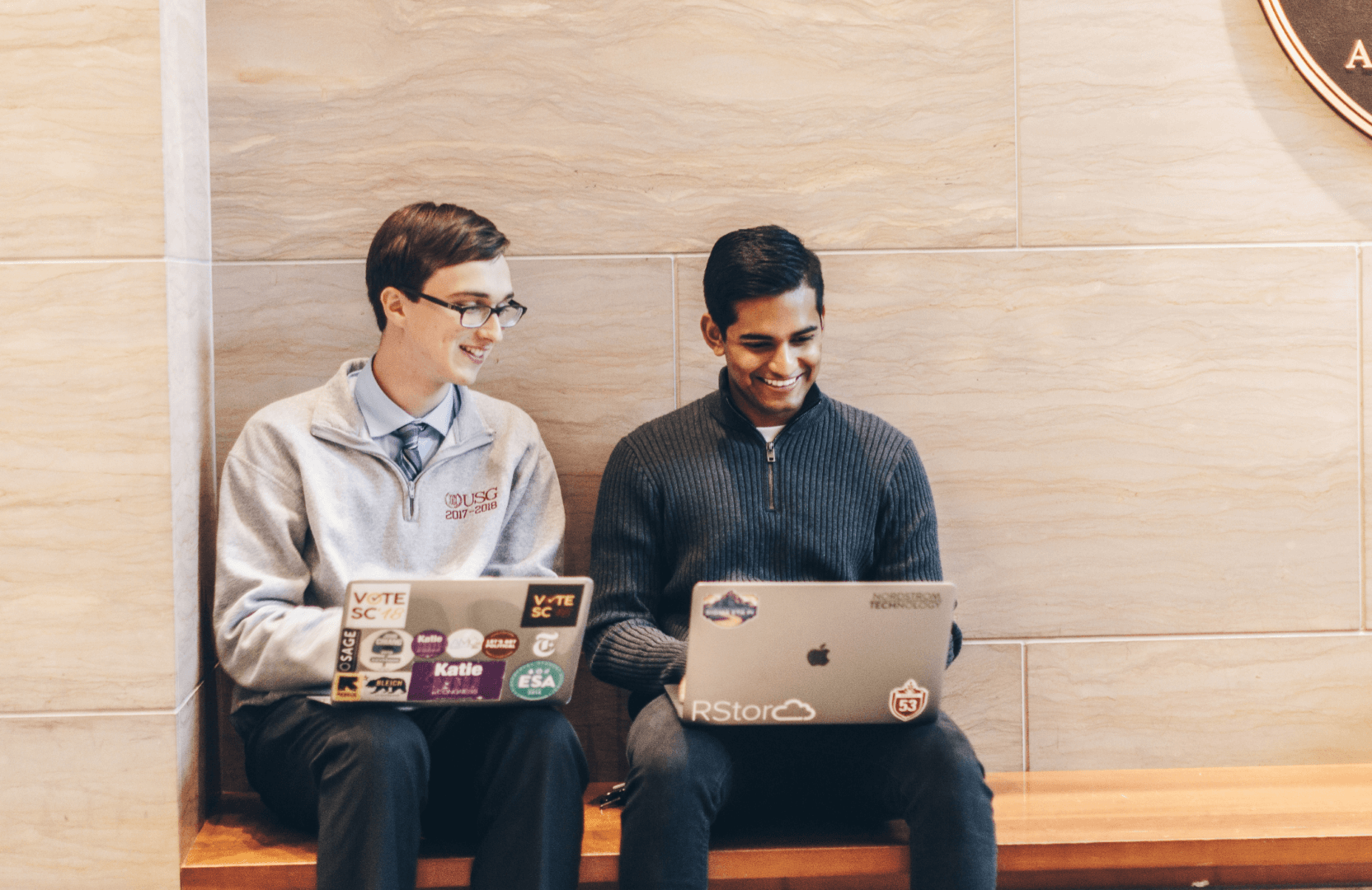Helping USC’s Homeless
As a young boy, Sandeep Suresh often accompanied his parents to Kochi in the Indian state of Kerala, his mother and father’s birthplace. Suresh, now a junior majoring in computer science at the USC Viterbi School of Engineering, has many fond memories of that distant land. However, one remembrance still haunts him to this day.
As Suresh and his parents walked through a dusty local market, an 8-year-old beggar approached. The bedraggled boy asked if he could have the Orange Fanta Suresh was drinking. What to Suresh was a half-empty, warm can of soda was liquid gold to the emaciated child, who broke into a huge grin when Suresh gave it to him.
Growing up in the Bay Area, Suresh said street people and squalor hid in plain sight amid the region’s opulence, just like in parts of India. Those brutal images troubled him. So, years later when Suresh matriculated at USC, he was thrilled when the professors of his Spark SC class assigned him and his teammates to come up with a project on homelessness. In time, they narrowed their focus, deciding to build a resource-rich website for housing and food-insecure USC students.
“It’s mind-boggling to me that a population like that exists here,” said Suresh, who launched the first version of the site in May 2017 with Alec Vandenberg, a junior at the USC Price School of Public Policy. “We wanted to bring light to the problem and help those forgotten students however we could.”
Over the past year-and-a-half, Suresh and Vandenberg have continuously updated the site, which gathers together in one place resources for the hungry and homeless, ranging from information about local food pantries to scholarships for indigent students to emergency housing services.
The website has filled a pressing need, said Brenda Wiewel, director of USC’s Initiative to Eliminate Homelessness.
“Some of our students have definitely used it,” said Wiewel, who has put a link to Suresh and Vanderberg’s site on the Initiative to Eliminate Homelessness’s homepage. “It’s a great thing.”
USC is believed to have hundreds of students who have had a challenge with getting enough food or may be struggling with housing at any given time.
Hunger and homelessness affect thousands of college students nationwide. According to the College and University Food Bank Alliance, half of all higher-education students have trouble putting food on the table. A division of the U.S. Department of Education reports an estimated 58,000 homeless students on American campuses.
Closer to home, about 10 percent of California State University’s students are homeless, while 20 percent lack regular access to enough food, according to a study commissioned by CSU Chancellor Timothy White.
Against this backdrop, Suresh began his journey into homeless advocacy, which has changed him as much as it has benefitted food and housing-insecure USC students.
When, as a freshman, his Spark SC team had to come up with an idea to address homelessness, Suresh felt a bit lost. Where to start? What to do? Then it all came together. After USC Provost Michael Quick guest lectured about the challenges facing the university, including homeless students, Suresh, Vandenberg and Sidharth Raguraman, who has since left the project, decided to create a website that would serve as an online hub for their peers in need.
Vandenberg, a public policy major, tracked down resources to feature on the website, which the budding engineer Suresh built. They met with Wiewel of the Initiative to Eliminate Homelessness for additional leads and advice. At this point, though, the idea of hungry, homeless students at USC seemed like something of an abstraction to Suresh.
Then he came face to face with the problem.
One night at 3 a.m., a procrastinating Suresh went to Leavey Library to work on a computer science assignment. Moments later, a student around his age sat down near him. He opened a book and put it face down; pulled his USC card out of his pocket and put it faceup on the desk; and then went to sleep on his backpack. Suresh left him a note saying he might be able to help.
The homeless student, a history major, soon got in touch. He told Suresh that his blue-collar father had injured himself on the job and could no longer send money to help with his expenses. The student could no longer pay rent and lost his apartment, soon spending many a night dozing in the library. He showered at USC’s Lyon Recreation Center and sought out campus events where he could eat free food. Suresh put him in touch with Wiewel, who helped the young man.
“After I met that student, that’s when I really started to feel it, to really want to make a difference in people’s lives,” Suresh said.
He and Vandenberg continued to work on their website, even after their Spark SC class ended. In reaction to user online feedback, Suresh simplified the design, dividing resources into three easy to access categories: USC, Los Angeles and national resources.
Vandenberg, now director of external affairs for the USC Undergraduate Student Government, helped publicize the homeless website through USG’s social media accounts. Vandenberg also leveraged his student government connections to make a film – with USG equipment – to raise awareness about homelessness on college campuses, including USC. That video now resides on his and Suresh’s site.
“We want to really breakdown the stigma surrounding this issue and open up doors for people in need,” Vandenberg said. “We want students to have conversations about these issues and to act as resources for one another.”
Working on the website has also had a profound effect on Suresh.
Like many students, he hoped to do well at USC Viterbi and then land a job at one of the blue-chip tech companies hungry for young, talented USC computer science graduates. Suresh said his goals have since changed.
“Working on this website made me realize that what’s most important to me is to help other people with my CS education to make their lives better,” he said. “I’m considering the nonprofit sector now.”

Trojan Engineers Combating Homelessness
1. New App to Coordinate Social Workers, Police, Hospitals
USC’s Digital Health Lab, or D-Health Lab, has developed an app that allows agencies serving local homeless populations to instantaneously share information. The app, created in conjunction with the city of Santa Monica, the Milken Institute and Akido Labs, gives social workers and others interacting with a particular homeless individual the ability to immediately see all available information about that person. Police officers can even leave a note on the app to contact case workers. A pilot program went live in Santa Monica in February. If successful, Karthik Murali, D-Lab director, said other cities might use the app, including Long Beach, whose officials have discussed it with him. Murali added that he could envision the city of Los Angeles one day embracing the app because of its large homeless population.
2. Using AI to Reduce Race Bias in Homelessness
Every year, an estimated 4 million youth experience homelessness in the United States. Policymakers prioritize finding stable housing for the most vulnerable among them. It turns out their methods fall a bit short. A study led by USC Viterbi’s Phebe Vayanos found that the current matching process generates matches that are neither maximally efficient nor necessarily fair. Vayanos estimates that a greater proportion of young people would have stayed off the streets for 12 months or longer if housing resources had been assigned by lottery. Additionally, the current system results in unequal outcomes by race, with a white youth being more likely than black and Latino youth to successfully exit homelessness. In light of these findings, Vayanos and her colleagues at the USC Center for Artificial Intelligence in Society (CAIS) have created an algorithm that leverages historical data to allocate the same housing resources in a more strategic and fair manner: their algorithm is estimated to eliminate 72 percent of racial disparities while improving efficiency by 16 percent.
3. USC Viterbi Writing Students Offer ‘Fresh Eyes’ on Skid Row
Last fall, students in Steve Bucher’s advanced writing class for engineers, Writing 340, worked on group consulting projects for the Weingart Center Association, a comprehensive provider of homeless services. At the end of the semester, student teams produced reports with recommendations on how Weingart might improve services, ranging from planting a green garden on the roof of a future center building on Skid Row to creating a multiplayer video game to build community and calm nerves by bringing people together. Students also made oral presentations to impressed Weingart leaders. “The main advantage of the students’ work is to have ‘fresh eyes’ looking at various issues in our operations,” said Kevin Murray, Weingart CEO and president and a former California state senator. “I was impressed with the nuance that they were able to pick up and incorporate into their ideas. I expect to implement most of them with the continued support of Viterbi.”




